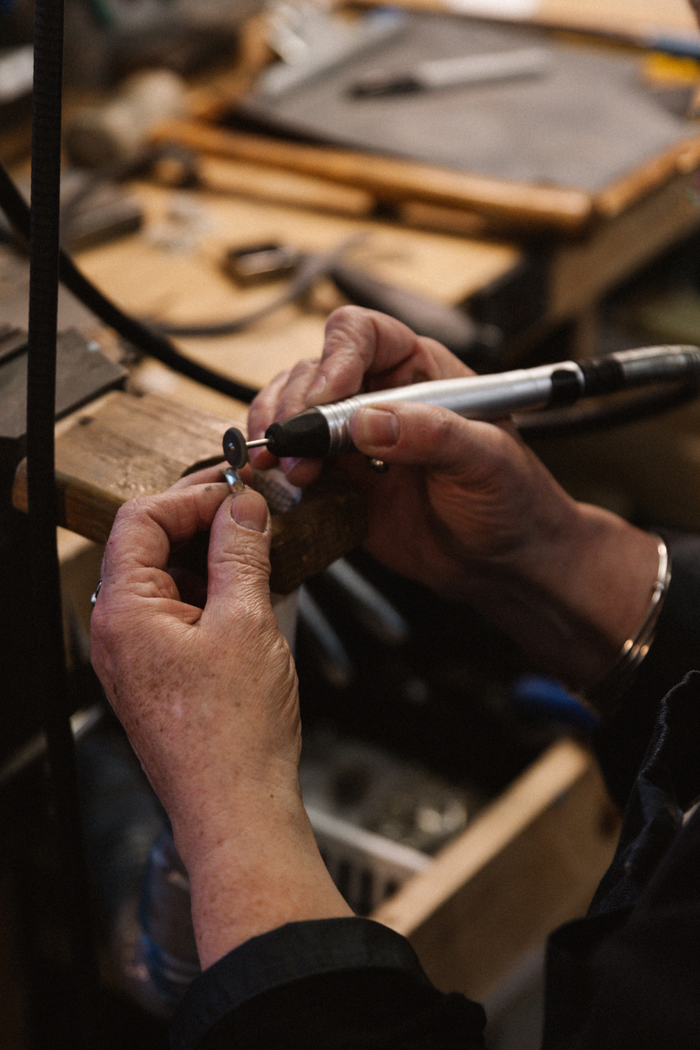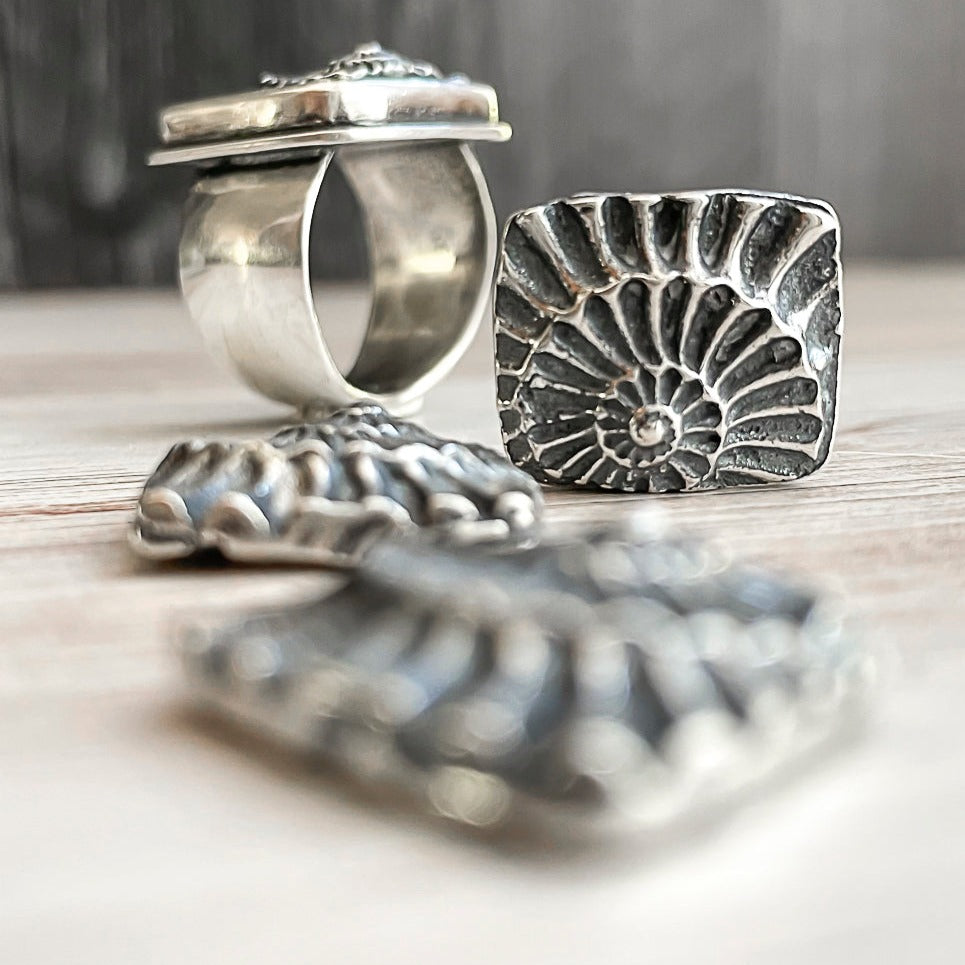
All Digital Tutorials
8 items
Here you will find a collection of jewelry making video tutorials and pdf downloads. All digital products are emailed to...

A silversmith, also known as a metalworker is a person who creates objects from silver. They saw, and cut shapes in fine or sterling silver sheet. They use a torch, hammers, stakes and anvils to form the metal into wonderful creations.
Silver has been mined and crafted into objects and jewelry for thousands of years. In the ancient times, silver was used to create jewelry, flatware and hollow ware. However silver was mainly used as a form of currency - coins.
The first forms of silver jewelry were from the Sumerian civilization in the Mesopotamia around 5000 BCE. They would create intricate earrings, necklaces and rings.

This Sumerian choker necklace is at The Met (not on view). I just can't even imagine how they made this much detail without the tools like I have today. I am not even sure I could!! LoL. You can find more info about this beauty on The Met website.
In ancient Egypt silver was rarer than gold and was highly valued. They associated silver with the moon so it was used in jewelry for both the living and the dead.
The Romans and the Greeks use silver for jewelry but also coins and artifacts. They saw it as a symbol of wealth and power.

Here is an example of a silver coin also on display at The Met. I certainly wish I lived closer to the museum so I could make regular trips. They have more info on the silver denarius in audio and you can listen HERE. Even their website is cool!
During the medieval era, there was a rise of artisan guilds. The silversmith guilds played a very important role in advancing the techniques and styles in jewelry making. The designs became more intricate and durable. These guilds throughout Europe and England would transmit their knowledge and tools of the craft to the next generation through the apprentice tradition. They were know for their very high standards but at the same time were reluctant towards innovations.
There were just a handful of female silversmiths within these guilds. They were most likely the widows of the master silversmith, and they were not allowed to inherit their husbands business. Therefore they were never formally recognized as silversmiths. The mans maker marks would always be stamped over their mark.
I am going to get a little ahead of the time line because I think it is important to mention Vivianna Torun from Sweden. She was the first female silversmith to be recognized internationally. You can find photos of some of her wonderful pieces on this Pinterest Board. At 21 she had her first exhibit and a few years later she opened her first studio around 1950. She was quoted saying that she did not want to make jewelry for wives of wealthy men to be locked up in private collections. She started creating jewelry what she called "the anti-status-jewely" made with twisted silver wire and adorned with crystals and stones. My kind of jewelry artist for sure.
Now to jump back in time to the Renaissance period. There was a big rebirth in the arts and culture after the medieval times (middle ages or dark ages) Silver jewelry became very popular. They would design jewelry with floral patterns and mythical creatures using new techniques. Silver and gold became a status symbol and you would see the wealthy wearing jewelry with many pearls, chains, brooches, or pendants with colorful enamel and gemstones. Below is a perfect example of the jewelry style during the Renaissance.

So extravagant and amazing. You can find more info about the triton riding a unicorn pendant at The Met here
When many started migrating to America in the late 1400s-1700s, the silversmiths of the European guilds saw fewer rules and restrictions in the fabrication of jewelry and artifacts. There was also the discovery of silver mines that boosted the European economy and became a significant trade commodity. These two factors eventually helped bring in new technology and began the shift towards industrialization.
As we come to the mid 19th century, another great contributor to the history of silversmithing is the Navajo tribe. They were forced to resettle in the reservation at Bosque Redondo NM by the US federal government. One of the many horrible moments in the US history. They called it the Long Walk.
There, they were influenced by the Spanish silversmiths. They started learning and creating the beautiful Silver Navajo Jewelry with turquoise and coral. In the early times the jewelry held cultural meaning, represented personal identity and status. Later with the rise of tourism in the southwest the amazing Navajo jewelry became very popular. It will always be one of my favorites. When I was in my teens I would spend many hours looking at the turquoise jewelry in one of the local jewelry stores. I would do random jobs to save money so I could buy as much turquoise jewelry I could.
There are so many more style and trends that are part of the silversmithing history but that would make this blog post way to long. Hopefully I will find the time to write other blog posts about different jewelry styles. I am a big fan of Art Deco Jewelry style. So I am going to fast forward to today. Here I am, along with so many other amazing and talented silversmiths in the world. We all have the passion and obsession to create beautiful shiny objects to adorn yourself with. We hope you enjoy and love them as much as we love creating them. Laura
Browse all handmade one of a kind jewelry HERE

8 items
Here you will find a collection of jewelry making video tutorials and pdf downloads. All digital products are emailed to...

71 items
Explore my made-to-order jewelry collection, featuring handcrafted rings, necklaces, earrings, and bracelets. Each piece is created just for you, ensuring...

153 items
Discover my one-of-a-kind jewelry collection, featuring unique rings, necklaces, earrings, and bracelets—each handcrafted in my Massachusetts studio. These exclusive designs...
Very interesting post!! Especially with all the links leading to the MET website, much informative.
Hi Sherry,
I am glad you enjoyed my blog post. I do tend to refer to myself as a metalsmith, however some people are confused and I clarify with silversmith. Laura
Hi Laura- thank you for the wonderful post and a wee stroll through the Met!
I’m curious if you when describing your art— do you refer to yourself as a silversmith or Metalsmith? (Or neither)
Best wishes-Sherry